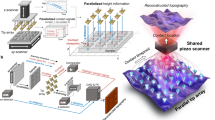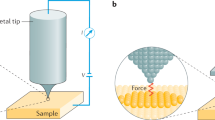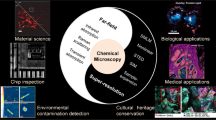Abstract
Microscopists have always pursued the development of an instrument that combines topography and materials properties analyses at the highest resolution. The measurement of the tiny amount of energy dissipated by a vibrating tip in the proximity of the sample surface has provided atomic force microscopes with a robust and versatile method to determine the morphology and the compositional variations of surfaces in their natural environment. Applications in biology, polymer science and microelectronics illustrate the potential of phase-imaging force microscopy for nanoscale analysis.
This is a preview of subscription content, access via your institution
Access options
Subscribe to this journal
Receive 12 print issues and online access
$259.00 per year
only $21.58 per issue
Buy this article
- Purchase on Springer Link
- Instant access to full article PDF
Prices may be subject to local taxes which are calculated during checkout





Similar content being viewed by others
References
Jung, T. A., Himpsel, F. J., Schlittler, R. R. & Gimzewski, J. K. in Scanning Probe Microscopy (ed. Wiesendanger, R.) 11–48 (Springer, Berlin-Heidelberg 1998).
Hillenbrand, R., Taubner, T. & Keilmann, F. Photon-enhanced light–matter interaction at the nanometre scale. Nature 418, 159–162 (2002).
Stroh, C. et al. Single-molecule recognition imaging-microscopy. Proc. Natl. Acad. Sci. USA 101, 12503–12505 (2004).
Martinez, N. F., Patil, S., Lozano, J. R. & García, R. Enhanced compositional sensitivity in atomic force microscopy excitation of the first two flexural modes. Appl. Phys. Lett. 89, 153115 (2006).
Meyer, E., Hug, H. J. & Bennewitz, R. Scanning Probe Microscopy: Lab on a Tip (Springer, Berlin, 2004).
Morita, S., Wiesendanger, R. & Meyer, E. (eds) Noncontact Atomic Force Microscopy (Springer, Berlin, 2002).
Jena, B. P. & Horber, J. K. H. Atomic Force Microscopy in Cell Biology (Academic Press, San Diego, 2002).
Garcia, R. & Perez, R. Dynamic atomic force microscopy methods. Surf. Sci. Rep. 47, 197–301 (2002).
Klinov, D. & Magonov, S. True molecular resolution in tapping-mode atomic force microscopy. Appl. Phys. Lett. 84, 2697–2699 (2004).
Chernoff, D. A. in Proc. Microscopy and Microanalysis (Bailey, G. W. et al. eds) 888–889 (Jones & Begell, New York, USA, 1995).
Tamayo, J. & García, R. Effects of elastic and inelastic interactions on phase contrast images in tapping-mode scanning force microscopy. Appl. Phys. Lett. 71, 2394–2396 (1997).
Magonov, S. N., Elings, V. & Papkov, V. S. AFM study of thermotropic structural transitions in poly (diethylsiloxane). Polymer 38, 297–307 (1997).
Rodriguez, T. R. & García, R. Tip motion in amplitude modulation (tapping-mode) atomic-force microscopy: comparison between continuous and point-mass models. Appl. Phys. Lett. 80, 1646–1648 (2002).
Legleiter, J., Park, M., Cusik, B. & Kowalewski, T. Scanning probe acceleration microscopy in fluids: Mapping mechanical properties of surfaces at the nanoscale. Proc. Natl Acad. Sci. USA 103, 4813–4818 (2006).
Hu, S. & Raman, A. Chaos in atomic force microscopy. Phys. Rev. Lett. 96, 036107 (2006).
Lee, M. & Jhe, W. General theory of amplitude-modulation atomic force microscopy. Phys. Rev. Lett. 97, 036104 (2006).
SanPaulo, A. & García, R. Tip-surface forces, amplitude, and energy dissipation in amplitude-modulation force microscopy. Phys. Rev. B 64, 193411 (2001).
Hölscher, H. Quantitative measurement of tip-sample interactions in amplitude modulation AFM. Appl. Phys. Lett. 89, 123109–123111 (2006).
García, R. et al. Identification of nanoscale dissipation processes by dynamic atomic force microscopy. Phys. Rev. Lett. 97, 016103 (2006).
Fukuma, T., Kimura, M., Kobayashi, K., Matsushige, K. & Yamada, H. Development of low noise cantilever deflection sensor for multienvironment frequency-modulation AFM. Rev. Sci. Instrum. 76, 053704 (2005).
Schäffer, T. E. Calculation of thermal noise in an atomic force microscope with a finite optical spot size. Nanotechnology 16, 664–670 (2005).
Ando, T. et al. High-speed AFM for studying the dynamic behaviour of protein molecules at work. Jpn J. Appl. Phys. 45, 1897–1903 (2006).
Humphris, A. D. L., Miles, M. J. & Hobbs, J. K. A mechanical microscope: High speed atomic force microscopy. Appl. Phys. Lett. 86, 034106 (2005).
Hansma, P. K., Schitter, G., Fantner, G. E. & Prater C. High-speed atomic force microscopy. Science 314, 601–602 (2006).
Thomson, N. H. The substructure of immunoglobulin G resolved to 25 kDA using amplitude modulation in air. Ultramicroscopy 105, 1003–110 (2005).
Stark, M., Stark, R. W., Heckl, W. M. & Guckenberger, R. Inverting force microscopy: From signals to time-resolved interaction forces. Proc. Natl Acad. Sci. USA 99, 8473–8478 (2002).
Kutana, A., Giapsis, K. P., Chen, J. Y. & Collier, C. P. Amplitude response of single-wall carbon nanotube probes during tapping mode atomic force microscopy: Modeling and experiment. Nano Lett. 6, 1669–1673 (2006).
Balantekin, M. & Atalar, A. Power dissipation analysis in tapping-mode atomic force microscopy. Phys. Rev. B 67, 193404 (2003).
Sahin, O., Quate, C. F., Solgaard, O. & Atalar, A. Resonant harmonic response in tapping-mode atomic force microscopy. Phys. Rev. B 69, 165416 (2004).
Martin, P., Marsaudon, S., Aimé, J. P. & Bennetau, B. Experimental determination of conservative and dissipative parts in the tapping mode on a grafted layer: comparison with frequency modulation data. Nanotechnology 16, 901–907 (2005).
Cleveland, J. P., Anczykowski, B., Schmid, A. E. & Elings, V. B. Energy dissipation in tapping-mode atomic force microscopy. Appl. Phys. Lett. 72, 2613–2615 (1998).
Bar G et al. Factors affecting the height and phase images in tapping mode atomic force microscopy. Study of phase-separated polymer blends of poly(ethene-co-styrene) and poly(2,6-dimethyl-1,4-phenylene oxide). Langmuir 13, 3807–3812 (1997).
Anczykowski, B., Gotsman, B., Fuchs, H., Cleveland, J. P. & Elings, V. B. How to measure energy dissipation in dynamic mode atomic force microscopy. Appl. Surf. Sci. 140, 376–382 (1999).
Stark, M., Möller, C., Müller, D. J. & Guckenberger, R. From images to interactions: High-resolution phase imaging in tapping-mode AFM. Biophys. J. 80, 3009–3018 (2001).
D'Amato, M. J., Markus, M. S., Eriksson, M. A. & Carpick, R. W. Phase imaging and the lever-sample tilt in dynamic atomic force microscopy imaging. Appl. Phys. Lett. 85, 4738–4740 (2004).
Bodiguel, H., Montes, H. & Fretigny, C. Depth sensing and dissipation in tapping mode atomic force microscopy. Rev. Sci. Instrum. 75, 2529–2535 (2004).
Kasai, T, Bhushan, B., Huang, L, & Chanmin, S. Topography and phase imaging using torsional resonance mode. Nanotechnology 15, 731–742 (2004).
Ashby, P. D. & Lieber, C. M. Ultra-sensitive imaging and interfacial analysis of patterned hydrophilic SAM surfaces using energy dissipation chemical force microscopy. J. Am. Chem. Soc. 127, 6814 (2005).
Martinez, N. F. & García, R. Measuring phase shifts and energy dissipation with amplitude modulation atomic force microscopy. Nanotechnology 17, S167–S172 (2006).
Xu, W. S., Wood-Adams, P. M. & Robertson, C. G. Measuring local viscoelastic properties of complex materials with tapping mode atomic force microscopy. Polymer 47, 4798–4810 (2006).
Oyabu, N. et al. Single atomic contact adhesion and dissipation in dynamic force microscopy. Phys. Rev. Lett. 96, 106101 (2006).
Loppacher, C. et al. Experimental aspects of dissipation force microscopy. Phys. Rev. B 62, 13674–13679 (2000).
Schirmeisen, A. & Hölscher, H. Velocity dependence of energy dissipation in dynamic force microscopy: Hysteresis versus viscous damping. Phys. Rev. B 72, 045431 (2005).
Waigh, T. A. Microrheology of complex fluids, Rep. Prog. Phys. 68, 685–742 (2005).
Gray, T. et al. Nanorheological approach for characterization of electroluminescent polymer thin films. Appl. Phys. Lett. 83, 2563–2565 (2003).
Reiter, G., Castelein, G., Sommer, J. U., Röttele, A. & Thurn-Albrecht, T. Direct visualization of random crystallization and melting in arrays of nanometer-size polymer crystals. Phys. Rev. Lett. 87, 226101 (2001).
Rehse, N., Marr, S., Scherdel, S. & Magerle, R. Three-dimensional imaging of semicrystalline polypropylene with 10 nm resolution. Adv. Mater. 17, 2203–2206 (2005).
Wu, W., Matyjaszewski, K. & Kowalewski, T. Monitoring surface thermal transitions of ABA triblock copolymers with crystalline segments using phase contrast tapping mode atomic force microscopy. Langmuir 21, 1143–1148 (2005).
Suo, Z. et al. HEPES-stabilized encapsulation of Salmonella typhimutium. Langmuir 23, 1365–1374 (2007).
Goede, K., Busch, P. & Grundmann, M. Binding specifity of a peptide on semiconductor surfaces. Nano Lett. 4, 2115–2120 (2004).
Checco, A., Cai, Y., Gang, O. & Ocko, B. M. High resolution non-contact AFM imaging of liquids onto chemically nanopatterned surfaces. Ultramicroscopy 106, 703–708 (2006).
Lysetska M. et al. UV light-damaged DNA and its interaction with human replication protein A: an AFM study. Nucleic Acids Res. 30, 2686–2691 (2002).
Uchihashi, T., Ando, T. & Yamashita, H. Fast phase imaging in liquids using a rapid scan atomic force microscope. Appl. Phys. Lett. 89, 213112 (2006).
Knoll, A., Magerle R. & Krausch, G. Phase behaviour in thin films of cylinder-forming ABA block copolymers. J. Chem. Phys. 120, 1105–1116 (2004).
Knoll, A. et al. Direct imaging and mesoscale modeling of phase transitions in a nanostructured fluid. Nature Mater. 3, 886–891 (2004).
Hahm, J., Lopes, W. A., Jaeger, H. M. & Sibener, S. J. Defect evolution in ultrathin films of polystyrene-block-polymethylmethacrylate diblock copolymers observed by atomic force microscopy. J. Chem. Phys. 109, 10111–10114 (1998).
Harrison, C. et al. Mechanisms of ordering in striped patterns. Science 290, 1558–1561 (2000).
Tsarkova, L., Knoll, A. & Magerle, R., Rapid transitions between defect configurations in a block copolymer melt. Nano Lett. 6, 1574–1577 (2006).
Xu, J. et al. Direct AFM observation of crystal twisting and organization in banded spherulites of chiral poly(3-hydroxybutyrate-co-3-hydroxyhexanoate). Macromolecules 37, 4118–4123 (2004).
Tamayo, J. Energy dissipation in tapping-mode scanning for microscopy with low quality factors. Appl. Phys. Lett. 75, 3569–3571 (1999).
Acknowledgements
This work was financially supported by the European Commission (FORCETOOL, NMP4-CT-2004-013684).
Author information
Authors and Affiliations
Ethics declarations
Competing interests
The authors declare no competing financial interests.
Rights and permissions
About this article
Cite this article
García, R., Magerle, R. & Perez, R. Nanoscale compositional mapping with gentle forces. Nature Mater 6, 405–411 (2007). https://doi.org/10.1038/nmat1925
Issue Date:
DOI: https://doi.org/10.1038/nmat1925
This article is cited by
-
Deconvolution of dissipative pathways for the interpretation of tapping-mode atomic force microscopy from phase-contrast
Communications Physics (2021)
-
Nanomechanical and Chemical Mapping of the Structure and Interfacial Properties in Immiscible Ternary Polymer Systems
Chinese Journal of Polymer Science (2021)
-
A Protein and Membrane Integrity Study of TiO2 Nanoparticles-Induced Mitochondrial Dysfunction and Prevention by Iron Incorporation
The Journal of Membrane Biology (2021)
-
Inhibiting and Remodeling Toxic Amyloid-Beta Oligomer Formation Using a Computationally Designed Drug Molecule That Targets Alzheimer’s Disease
Journal of the American Society for Mass Spectrometry (2019)
-
Fast and high-resolution mapping of elastic properties of biomolecules and polymers with bimodal AFM
Nature Protocols (2018)



